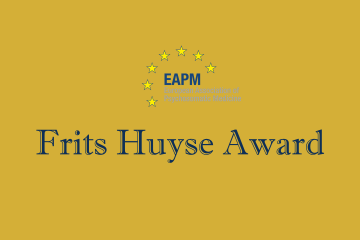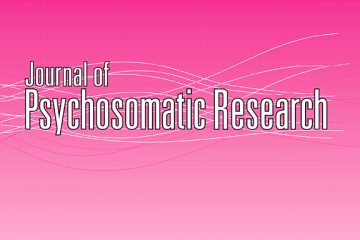JPR: The Editor’s choice
The Editor’s choice March 2019
written by Jess G. Fiedorowicz, Editor-in-Chief, Journal of Psychosomatic Research, March 2019

Jess Fiedorowicz, JPR’s Editor-in-Chief:
The following article has been selected by Jess Fiedorowicz, JPR’s Editor-in-Chief:
Article title:
Factors affecting self-reported chemical intolerance: A five-year follow-up study in Japan
Kenichi Azuma, Iwao Uchiyama, Naoki Kunugita
Vol. 118 p1-8
I’m excited to announce the Editor’s Choice from the Journal of Psychosomatic Research for this March 2019 quarterly newsletter of the European Association of Psychosomatic Medicine. Of the two finalist articles that I selected, “Factors affecting self-reported chemical intolerance: A five-year follow-up study in Japan” by Kenichi Azuma, Iwao Uchiyama, and Naoki Kunigita was the unanimous favorite of the Associate Editors and I [1]. These collaborators from Osakasayama, Kyoto, and Wako Japan concisely summarize their findings in the following edited passage:
Chemical intolerance is often associated with psychosomatic states, but little is known about the effects of these states on the course of chemical intolerance. A 5-year follow-up study was conducted with 735 individuals with chemical intolerance and 1750 controls without chemical intolerance identified from a cohort of 7245 adults at baseline. Baseline negative psychosomatic states, including irritability, fatigue, anxiety, depressed mood, and somatic symptoms were associated with development of chemical intolerance in controls. Appropriate physical activity and maintaining a regular lifestyle, including diet or sleep, were factors for improvement of chemical intolerance. Stable psychosomatic state is essential for preventing chemical intolerance.
This exceptional sample, a prospective cohort of more than 7000 participants, in a study designed specifically for chemical intolerance was followed for five years. This provided the opportunity to assess prognosis of prevalent cases, incidence of new cases, as well as risk and protective factors for development of chemical intolerance. In doing so, they identified several clinically relevant findings. Associate Editor Bernd Löwe summarized it best — “great sample, nice prospective analyses of risk factors, plausible results – exceptionally convincing!”
Azumi et al.’s promising work was also highlighted in an Editorial by Eva Palmquist of Stockholm University in Sweden [2]. This editorial nicely summarizes some of the clinical and nosological challenges that chemical intolerance can present. She noted the lack of prospective research in this area and highlighted two prior prospective, population-based studies of the topic, both of which were also published in the Journal of Psychosomatic Research [3, 4]. All three five-year follow-up studies converge on the finding that psychosomatic factors predict the onset of chemical intolerance. The specific variables measured varied across studies, but those associated with chemical intolerance included subjective health complaints, stress, anxiety, and neuroticism. Azuma and colleagues extend this research by also looking at environmental factors in a study focused on chemical intolerance, the Japanese Chemical Intolerance study. Over five years of follow-up, 67.7% of those with chemical intolerance improved. They found that a lifestyle characterized by regular physical activity predicted improvement. Conversely, changes in one’s residence (e.g., ventilation, renovation) were not helpful and changing one’s residence altogether rendered improvement significantly less likely. Although models included several co-morbidities as covariates, the potential for residual confounding or illness severity influencing findings remains possible in this observational study.
The finding that changing residence was associated with being less likely to recover from chemical intolerance is particularly interesting given the association between chemical intolerance and avoidance behaviors and the purported environmental etiologies for chemical intolerance. As noted in the Palmquist editorial, “neither toxicological/pathophysiological or psychological theories alone have (yet) been able to satisfactorily explain chemical intolerance [5].” This Editor’s choice is certain to be a high impact paper on the topic of chemical intolerance. It provides compelling confirmation of the importance of psychosomatic factors. It provides information on prognosis and risk/protective factors. It provides clinical insights that we can use today. Clinicians should focus on lifestyle interventions over interventions in the home. The authors speculate that exercise might be beneficial by restoring autonomic balance, abnormalities of which have been associated with the illness. Future prospective studies looking at physiological measures may be able to begin to answer some of these important mechanistic questions. In the meantime, we can provide guidance to patients about what can help while potentially avoiding expenses that might be without benefit.
References:
[1] K. Azuma, I. Uchiyama, N. Kunugita, Factors affecting self-reported chemical intolerance: A five-year follow-up study in Japan, J Psychosom Res 118 (2019) 1-8. [2] E. Palmquist, Chemical intolerance – A puzzling condition, J Psychosom Res 118 (2019) 69-70. [3] F. Eek, B. Karlson, K. Osterberg, P.O. Ostergren, Factors associated with prospective development of environmental annoyance, J Psychosom Res 69(1) (2010) 9-15. [4] S. Skovbjerg, K.B. Christensen, J.F. Ebstrup, A. Linneberg, R. Zachariae, J. Elberling, Negative affect is associated with development and persistence of chemical intolerance: a prospective population-based study, J Psychosom Res 78(5) (2015) 509-14. [5] S. Rossi, A. Pitidis, Multiple Chemical Sensitivity: Review of the State of the Art in Epidemiology, Diagnosis, and Future Perspectives, J Occup Environ Med 60(2) (2018) 138-146.Please see:
and
https://www.journals.elsevier.com/journal-of-psychosomatic-research



0 Comments